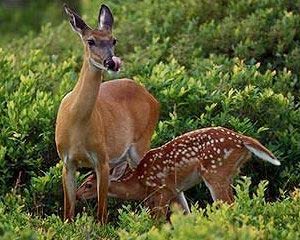The mother does not recognize her
The deer were very quick to recognize their mother's calling, but it was these wild mothers who could not recognize their children based solely on the cries, a recent finding said.

(Photo: americazoo.com)
Using tape recordings and replaying in experiments on wild Swiss deer, the researchers found that the adult females had a distinct call, but the deer didn't. Therefore, even if the deer discovers its mother's voice in the countless voices of other mothers, a mother deer cannot know the cry of her child.
The researchers surmised that this one-way system was formed because deer lived in a typical environment with many bushes as a shelter for newborn deer - clumsy creatures who had to rely on mothers for weeks after birth to survive.
In the first 2-3 weeks of life, the baby deer is hidden and silent under the tree. Mothers spend most of the day away from their nests, but will come back constantly to take care of it.
In order to know where the baby is hiding, the mother deer approaches the approximate position of the baby deer lying and crying. The baby deer will step back to find the meal. And like the final identity test, the mother deer will smell the little animal to make sure it's her baby.
In contrast, the offspring of the reindeer, relatives of the Swiss wild deer, were immediately alert after their birth. They can follow their heels and know to run away from the enemy.
Wild deer and reindeer therefore belong to two different groups of hooves, which biologists respectively call " hidden " species and " stalk " species, based on the strategy each group uses to avoid enemies. .
"Our results indicate that different environmental conditions affect the strategy of avoiding the enemy and also affect the evolution of different mother-child identification mechanisms," study co-author Alan McElligott. from the University of Zurich said.
T. An
- Learn the history and meaning of Mother's Day
- Father and mother are well known for their crying children
- Cuba successfully abolished mother-to-child HIV infection
- Beam of photos: Mother bear carrying pig bear across the stream
- Crow can recognize human voices
- Mother whales lower their voices, whispering to their babies to avoid being spotted by hunters
- Video: Winged mother chickens protect the cubs in the stormy weather
- Angry mother elephants threaten lions to protect them
- Video: Elephants cry for 5 hours because of their mother's neglect
- Attendance of countries that recognize same-sex marriage
- Computers can recognize user moods
- Believe in the mother instinct
 Animal 'suffering' after hibernation
Animal 'suffering' after hibernation Why do goats climb well?
Why do goats climb well? Scientists were surprised to see chimpanzees eating turtles
Scientists were surprised to see chimpanzees eating turtles Giant catfish died deadly due to drought in Thailand
Giant catfish died deadly due to drought in Thailand